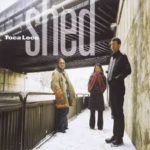Though technically not true, we often think about this work as being the very first “Toca Loca” piece. It was written just for the trio, and it really spoke to the kind of music we wanted to be playing – virtuosic, punchy, sonically compelling and, most importantly, FUN. It might be the mechanical/industrial references in the movement titles, but the piece seem to go by like a train ride in an action movie. It is full of rhythmic drive and has solos for each player to showcase their chops, with lots of pitfalls to dodge and challenges to overcome. The electronics are well conceived and blend in well with the instruments, while containing many moments of interest. There is an optional version of this piece that we perform where we replace one of the pianos with a Rhodes. This is purely a pragmatic alternative, for when we are performing in venues with only one piano. It still works as a piece, but I do miss the prepared piano sonorities. It occurs to me that during the solo, one could experiment with effects pedals, probably with varying levels, to give it a bit more colour. The piece is not especially tricky if you have the technical facility. Ironically, one of the hardest parts for us to get to a reasonable level of consistency was the slow movement, where the pianos are playing inside on the strings. There is a lot of detail there, and you really need to get comfortable with plucking/strumming. I’m also not convinced that I’ve ever played the end of the 1st movement completely accurately, but then again, I’m not sure I would be able to tell either way. Optional section: Notes to the Performer:
Title: Adventure Music: Love her madly Composer: Andrew Staniland Country: Canada Duration: 15 min Date of Composition: 2006 Publisher: Canadian Music Centre How to get score: Digital or print or loan Commission: Toca Loca/Toronto Arts Council Dedication: Premiere: Performance History: Discography:
ANDREW STANILAND – ADVENTURE MUSIC: LOVE HER MADLY. *I Driven *Adventure:* /an exciting or very unusual experience. /*Music:* /an art of sound in time that expresses ideas and emotions in significant forms through the elements of rhythm, melody, harmony, and color: /*Love:* /strong predilection, enthusiasm, or liking for anything: /*Her:* /anything considered, as by personification, to be feminine: *Madly:* In a wild manner; frantically./ This piece was commissioned with the assistance of the Toronto Arts Council. Described as a “new music visionary” (National Arts Centre), composer Andrew Staniland has established himself as one of Canada’s most important and innovative musical voices. His music is performed and broadcast internationally and has been described by Alex Ross in the New Yorker Magazine as “alternately beautiful and terrifying”. Among other accolades, Andrew is the recipient of two Juno nominations for Dark Star Requiem in 2017, was awarded the Terra Nova Young Innovators Award in 2016, was the National Grand Prize winner of EVOLUTION (presented in 2009 by CBC Radio 2/Espace Musique and The Banff Centre), and was the recipient of the Karen Keiser Prize in Canadian Music in 2004. As a leading composer of his generation, Andrew has been recognized by election to the Inaugural Cohort of the College of New Scholars, Artists and Scientists Royal Society of Canada. Andrew was an Affiliate Composer to the Toronto Symphony Orchestra (2006-09) and the National Arts Centre Orchestra (2002–04), and has also been in residence at the Centre du Creation Musicale Iannis Xenakis (Paris, 2005). Recent commissioners include the National Arts Centre Orchestra, the Brooklyn Art Song Society, cellist Frances-Marie Uitti, and Les Percussions de Strasbourg. Andrew also performs as a guitarist and with new media (computers and electronics). Andrew is currently on faculty at Memorial University in St John’s Newfoundland, where he founded MEARL (Memorial ElectroAcoustic Research Lab). At MEARL, Andrew leads a cross-disciplinary research team that has produced the innovative Mune digital instrument: www.munemusic.com
 SHED – Toca Loca – Henceforth Records | iTunes | Spotify
SHED – Toca Loca – Henceforth Records | iTunes | Spotify
II Free, rubato – Humourously mechanical – Meditative III Like an industrial machine* *












